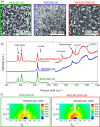Improved Gas Sensing Capabilities of MoS2/Diamond Heterostructures at Room Temperature
- PMID: 37394733
- PMCID: PMC10360066
- DOI: 10.1021/acsami.3c04438
Improved Gas Sensing Capabilities of MoS2/Diamond Heterostructures at Room Temperature
Abstract
Molybdenum disulfide (MoS2) and nanocrystalline diamond (NCD) have attracted considerable attention due to their unique electronic structure and extraordinary physical and chemical properties in many applications, including sensor devices in gas sensing applications. Combining MoS2 and H-terminated NCD (H-NCD) in a heterostructure design can improve the sensing performance due to their mutual advantages. In this study, the synthesis of MoS2 and H-NCD thin films using appropriate physical/chemical deposition methods and their analysis in terms of gas sensing properties in their individual and combined forms are demonstrated. The sensitivity and time domain characteristics of the sensors were investigated for three gases: oxidizing NO2, reducing NH3, and neutral synthetic air. It was observed that the MoS2/H-NCD heterostructure-based gas sensor exhibits improved sensitivity to oxidizing NO2 (0.157%·ppm-1) and reducing NH3 (0.188%·ppm-1) gases compared to pure active materials (pure MoS2 achieves responses of 0.018%·ppm-1 for NO2 and -0.0072%·ppm-1 for NH3, respectively, and almost no response for pure H-NCD at room temperature). Different gas interaction model pathways were developed to describe the current flow mechanism through the sensing area with/without the heterostructure. The gas interaction model independently considers the influence of each material (chemisorption for MoS2 and surface doping mechanism for H-NCD) as well as the current flow mechanism through the formed P-N heterojunction.
Keywords: H-terminated diamond; MoS2; MoS2/H-NCD heterostructure; P−N junction; gas interaction model; gas sensors; room temperature; sensitivity.
Conflict of interest statement
The authors declare no competing financial interest.
Figures








References
-
- Dhall S.; Mehta B. R.; Tyagi A. K.; Sood K. A review on environmental gas sensors: Materials and technologies. Sens. Int. 2021, 2, 100116.10.1016/j.sintl.2021.100116. - DOI
-
- Zhou Y.; Liu G.; Zhu X.; Guo Y. Ultrasensitive NO2 gas sensing based on rGO/MoS2 nanocomposite film at low temperature. Sens. Actuators, B 2017, 251, 280–290. 10.1016/j.snb.2017.05.060. - DOI
-
- Neetika; Kumar A.; Chandra R.; Malik V. K. MoS2 nanoworm thin films for NO2 gas sensing application. Thin Solid Films 2021, 725, 138625.10.1016/j.tsf.2021.138625. - DOI
-
- Reddeppa M.; Park B.-G.; Murali G.; Choi S. H.; Chinh N. D.; Kim D.; Yang W.; Kim M.-D. NOx gas sensors based on layer-transferred n-MoS2/p-GaN heterojunction at room temperature: Study of UV light illuminations and humidity. Sens. Actuators, B 2020, 308, 127700.10.1016/j.snb.2020.127700. - DOI
-
- Yan H.; Song P.; Zhang S.; Zhang J.; Yang Z.; Wang Q. A low temperature gas sensor based on Au-loaded MoS2 hierarchical nanostructures for detecting ammonia. Ceram. Int. 2016, 42, 9327–9331. 10.1016/j.ceramint.2016.02.160. - DOI
LinkOut - more resources
Full Text Sources

